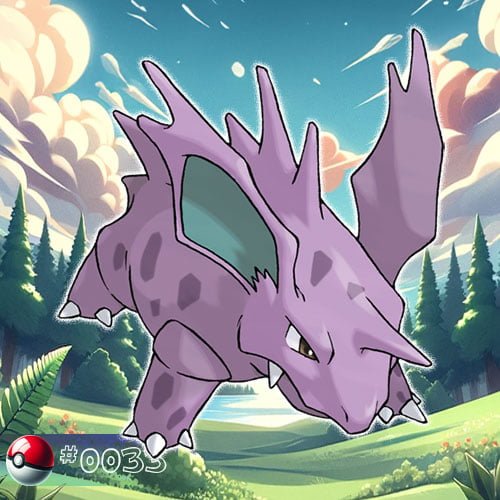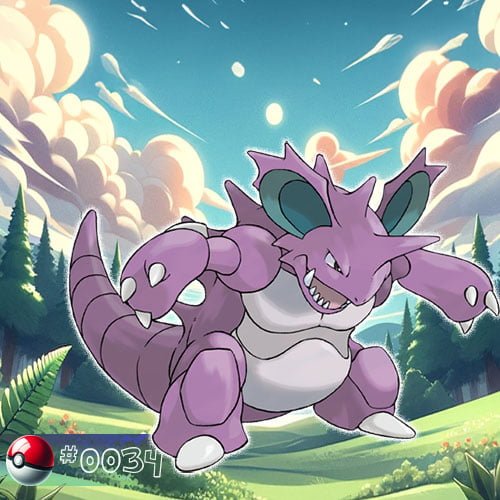Nidorino
Nidorino is a Poison-type, the male counterpart to Nidorina. In the Pokémon games and anime, Nidorino is often depicted as a formidable and resilient Pokémon.

| National Pokedex No: 0033 |
| Type: |
| Category: Poison Pin Pokémon |
| Height: 0.9 m (2′11″) |
| Weight : 19.5 kg (43.0 lbs) |
| Gender: 100% ♂, 0 % ♀ |
| Abilities/Hidden abilities: Poison Point or Rivalry/Hustle |
Biology
Physical Characteristics
Here is a detailed description of Nidorino’s physical characteristics.
Nidorino has a robust and well-built body with strong, muscular limbs. Its physique reflects its evolution from the smaller and more delicate Nidoran♂. The primary color of Nidorino’s body is a deep purple hue, which gives it a distinct and visually striking appearance. Yellow markings are prominent on various parts of its body, including the ears, eyes, chest, and back.
The horn on Nidorino’s forehead is a defining feature, significantly larger and more pronounced than the one on Nidoran♂. This horn serves both defensive and offensive purposes, making Nidorino a formidable opponent in battles.
Nidorino’s ears are large and pointed, adding to its overall menacing look. The upright stance of the ears enhances its alert and aggressive appearance. The eyes of Nidorino are notable for their intense red color and slit pupils, contributing to its fierce and predatory expression.
Nidorino’s tail is long and flexible, ending with a sharp barb. This tail is a notable feature that adds to its defensive capabilities. It possesses four limbs, each equipped with three sharp claws. These limbs showcase its physical prowess and adaptability in combat situations.
Additional horn-like spines adorn Nidorino’s back, emphasizing its Poison-type nature. These spines may serve defensive purposes or play a role in its territorial displays.
Nidorino’s intricate design incorporates these features to create a visually captivating and formidable Pokémon, suitable for both defensive strategies and powerful attacks in the Pokémon world.
Behaviour
Nidorino, like many Pokémon, exhibits various behaviors influenced by its instincts, environment, and interactions. Here are details about the behavior of Nidorino.
Nidorino is known for its aggressive nature, especially during the mating season or when defending its territory. Its intimidating appearance, including the large horn, contributes to this behavior. In the wild, Nidorino establishes and fiercely defends its territory. It may engage in battles with other Pokémon to assert dominance and protect its space.
Nidorino is a skilled combatant, using its sharp claws and horn for both offense and defense. It employs a variety of physical attacks and may exhibit strategic thinking in battles. Like many Pokémon, Nidorino communicates through body language, vocalizations, and other non-verbal cues. It may use its horn and tail movements to convey emotions or intentions.
During the breeding season, male Nidorino engage in elaborate displays to attract females. This may involve showcasing their strength, agility, and the size of their horns to impress potential mates. If a Nidorino forms a bond with a Trainer, it can develop strong protective instincts. It may exhibit loyalty and defend its Trainer from perceived threats.
Nidorino may form small groups or communities in the wild, particularly during certain times of the year. However, it generally prefers a solitary lifestyle. Nidorino’s diet likely consists of a combination of plants and small prey. Its sharp claws and teeth aid in hunting and foraging.
Nidorino is known to be active during the night, showcasing a nocturnal behavior pattern. This behavior might be influenced by factors such as hunting opportunities or avoiding predators.
When trained by a skilled Trainer, Nidorino can adapt its behavior to follow commands and work as a team in battles. Positive reinforcement and a strong bond with its Trainer are crucial for effective training.
Understanding these behaviors helps Trainers and researchers develop effective strategies for capturing, training, and caring for Nidorino in both wild and domesticated settings.
Evolution
The evolutionary line begins with Nidoran♂, a Poison-type Pokémon. Nidoran♂ evolves into Nidorino starting at level 16. The evolution is a natural and automatic process that occurs as Nidoran♂ gains experience in battles and other activities.
The evolution brings about several physical changes in Nidorino’s appearance. Notable transformations include the development of a larger horn on its forehead, increased size and muscularity, and a more imposing stance.
Nidorino’s evolution signifies an increase in its battle prowess. It gains access to new and more powerful Poison-type moves, making it a more formidable opponent in battles.
Unlike its next evolutionary stage, Nidoking, Nidorino doesn’t require an Evolutionary Stone for its evolution. It undergoes a natural growth process triggered by experience and leveling up. Nidorino can evolve into Nidoking when exposed to a Moon Stone. This evolution results in a more significant transformation, including changes in appearance, stats, and movepool.
Evolution generally brings an increase in base stats, making Nidorino more resilient and powerful. Evolving to Nidorino expands the range of moves it can learn and use, enhancing its versatility in battles.
Trainers often decide when to evolve their Nidorino based on strategic considerations. Some may prefer to delay evolution to learn specific moves earlier, while others might evolve it as soon as possible to access higher base stats. The Nidorino evolutionary line is completed with the further evolution of Nidorino into Nidoking. This usually occurs when a Trainer decides to use a Moon Stone on their Nidorino.
Understanding the evolution of Nidorino is essential for Trainers aiming to maximize the potential of their Pokémon in battles and competitions. Whether to keep Nidorino in its current form or evolve it into Nidoking depends on the Trainer’s goals and strategic preferences.
Appearances
Anime Main Appearances
In the Pokémon ”I Choose You!” episode, a Nidorino faced off against a Gengar in a televised battle witnessed by Ash. This marked the initial appearance of Pokémon in the anime, excluding the opening scenes.
During the Indigo Plateau Conference (championship competition) in ”Fire and Ice”, Ash engaged in a battle with a Nidorino. This encounter was later revisited in a flashback in ”Friends to the End”.
Ralph’s Nidorino, Tony, evolved from Nidoran♂ after battling Team Rocket and kissing Emily’s Nidoran♀, Maria in the epsode ”Wherefore Art Thou, Pokémon?”. Temacu’s Nidorino was seen taking a stroll with her Nidorina in the episode ”The Heartbreak of Brock”. In another instance, Jessie attempted to capture Aerodactyl using a Nidorino she obtained from the Rocket Prize Master but was unsuccessful.
Anime Minor Appearances
In various Pokémon episodes and movies, Nidorino made appearance.
Numerous Nidorino were spotted at ”Laramie Ranch”, and in the banned episode ”EP035”, two were featured in a flashback. A Nidorino, injured and in need of care, appeared in ”A Chansey Operation”. In ”Mewtwo Strikes Back”, a Trainer’s Nidorino faced defeat at the hands of Mewtwo while serving Giovanni.
The ”Legend of Thunder!” featured two Nidorino, and multiple were part of the opening sequence in ”Destiny Deoxys”.
Other appearances include these episodes: ”The Power of One”, ”A Tent Situation”, ”Pokémon Swap Meet”, ”The Legend of Thunder!” (two Nidorino were seen), ”Pokémon Ranger and the Kidnapped Riolu! Part 1”, ”Arceus”, ”Jewel of Life’, ”Zoroark: Master of Illusions”, ”Genesect and the Legend Awakened” (seen in a Mewtwo’s flashback), in ”Mewtwo Strikes Back—Evolution” and in ”This Could be the Start of Something Big!”.
Manga Appearances
Pokémon Adventures
Nidorino made its debut in “A Glimpse of the Glow,” captured by Red to demonstrate Pokémon catching to the Pallet Town children. Another Nidorino featured in Red’s fantasy explanation about Pokémon to the children.
In “Return to Pallet Town,” a wild Nidorino emerges later on. Red encourages a child to use the Gengar on his belt to battle and weaken the Nidorino, referencing the opening sequence of Pokémon FireRed and LeafGreen remakes.
Pokémon Pocket Monsters
In the fortieth chapter of the Pokémon Pocket Monsters manga – ”Save the Pokémon Zoo!!” (PM040) appeares a Nidorino owned by Professor Oak.
Game data
Stats
Location
| Game version | Location |
|---|---|
| Pokémon Red and Pokémon Blue | Evolve Nidorino |
| Pokémon Yellow | Evolve Nidorino |
| Pokémon Gold and Pokémon Silver | Evolve Nidorino |
| Pokémon Crystal | Evolve Nidorino |
| Pokémon Ruby and Pokémon Sapphire | Trade |
| Pokémon FireRed and Pokémon LeafGreen | Evolve Nidorino |
| Pokémon Emerald | Trade |
| Pokémon Colosseum | Trade |
| Pokémon XD | Trade |
| Pokémon Diamond and Pokémon Pearl | Evolve Nidorino |
| Pokémon Platinum | Evolve Nidorino |
| Pokémon HeartGold and Pokémon SoulSilver | Evolve Nidorino |
| Pokémon Black | Trade |
| Pokémon White | Evolve Nidorino |
| Pokémon Black 2 and Pokémon White 2 | Evolve Nidorino |
| Pokémon X and Pokémon Y | Evolve Nidorino |
| Pokémon Omega Ruby and Pokémon Alpha Sapphire | Trade |
| Pokémon Sun and Pokémon Moon | Trade (Pokémon Bank) |
| Pokémon Ultra Sun and Pokémon Ultra Moon | Trade (Pokémon Bank) |
| Pokémon: Let's Go, Pikachu! And Pokémon: Let's Go, Eevee! | Route 23 |
| Pokémon Sword and Pokémon Shield | Trade |
| Pokémon Brilliant Diamond and Pokémon Shining Pearl | Evolve Nidorino |
| Legends Arceus | Unobtainable |
| Pokémon Scarlet and Pokémon Violet | Unobtainable |
| Pokémon Scarlet and Pokémon Violet | Unobtainable |
Nidorino's origin name
Nidorino’s name is a combination of “needle” and “rhinoceros,” reflecting its physical characteristics and design. Here are the some details.
English: Nidorino’s English name combines “needle” (referring to its toxic spines) and “rhino” (short for rhinoceros, indicating its horned appearance).
Japanese: In Japanese, Nidorino is known as “ニドリーノ” (Nidoriino).
French: In French, Nidorino retains a similar name, being called “Nidorino.”
German: The German name for Nidorino is also similar, being “Nidorino.”
Spanish: In Spanish, Nidorino maintains consistency with its English name and is called “Nidorino.”
Italian: The Italian name for Nidorino is “Nidorino.”
Korean: In Korean, Nidorino is written as “니드리노” (Nidurino).
Chinese (Simplified and Traditional): In both Simplified and Traditional Chinese, Nidorino is represented as “尼多力诺” (Níduōlìnuò).
The consistent use of elements like “needle” and “rhino” reflects the core aspects of Nidorino’s design and abilities.




